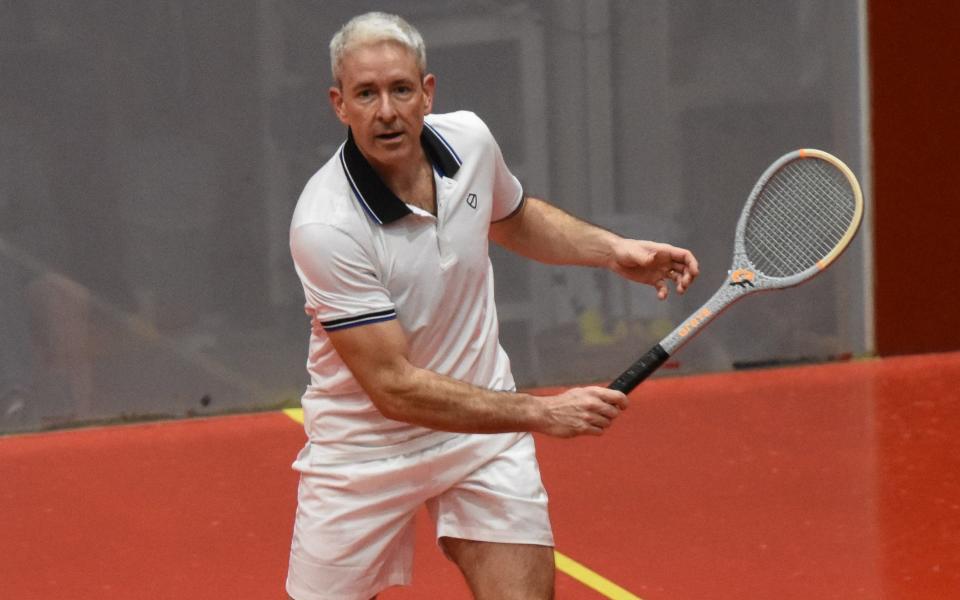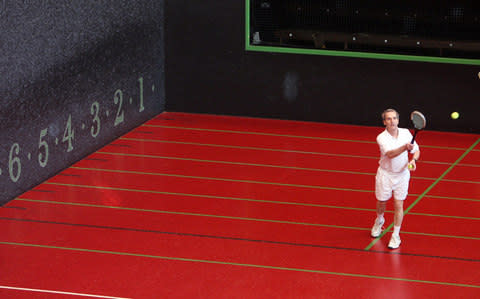Rob Fahey, the Roger Federer of real tennis, aims to celebrate his 50th birthday with yet another world title

As a middle-aged reporter, there are few experiences more rare and precious than meeting a world-class sportsman whose hair is whiter than your own.
Rob Fahey is a case in point. The most successful player in the history of real tennis, he is about to take on a young American named Camden Riviere for the world championship title. The fact that Fahey will celebrate his 50th birthday on Monday week doesn’t seem to bother him, although he does admit that “I’m going to be the biggest underdog since the 1930s.”
Real tennis – Henry VIII’s favourite game, and the ancestor of Wimbledon’s “lawn” tennis – is a fine choice for a silver fox, because wiliness outperforms fitness every time.
The rules of this bizarre sport – a Byzantine combination of tennis, squash and pinball – are too complex to detail here. Suffice it to say that each point (or “reste”, technically) begins with the ball being served onto a sloping roof, known as the penthouse. It then gurgles its way around the court before landing with the chanciness of a roulette wheel. Through sheer experience, a 70-year-old with two false hips is more likely to make the return than a fit young debutant.

Yet while brains might be essential, brawn plays its part too. Next week’s play-off is a three-day event scheduled for Tuesday, Thursday and Saturday. Fahey and Riviere are likely to spend around three hours on court each time, followed by a rest day which offers opportunity for deep tactical analysis in the manner of a Fischer-Spassky chess series.
“The thing which distinguishes the top guys from the club players is usually the ability to read the spin,” says Riviere of a sport with at least 15 styles of service, each named after its inventor. “The ball sometimes strikes six different surfaces before you hit it.”
Before world championships, players are banned from watching their rivals practise, in case they pick up clues. When Fahey beat Riviere in the 2014 final, he ambushed him with an attritional gameplan that relied on fitness, drawing out rallies in a manner that no-one had expected from a 45-year-old. “He was off the grid for three or four months preparing,” recalls Riviere now. “Then he came back looking like a marathon runner.”
These two could be compared to Roger Federer and Rafael Nadal. Fahey – an amiable Aussie who now lives in Essex – has won a colossal 49 Open titles, more than twice as many as anyone else. Riviere, who is 30, is left-handed and hugely physical in his style. “The way I play, I won’t last as long as Rob,” he says. “I’ll be amazed if I’m still winning at 40.”

Real tennis has around 50 courts worldwide. They differ in minor ways, but all follow the basic layout established in the 16th century. The sport sustains perhaps 75 professionals, who are almost all coaches. If you sweep the whole circuit, as Riviere has for the last four seasons, you collect something like £25,000.
Still, what this sport loses in wealth and accessibility (the scoring system feels like a cryptocurrency), it gains in addictiveness. Fahey stumbled across real tennis via a job advertisement in his local Hobart paper, some time in the late 1980s. Thirty years later, he is still practising at Queen’s Club in south-west London – the venue for next week’s match – with the intensity of a love-struck teenager.
As Peter Allis said of Fred Couples during the recent Masters, “There may be snow on the roof, but there’s still fire in the grate.”

 Yahoo Sport
Yahoo Sport 





































